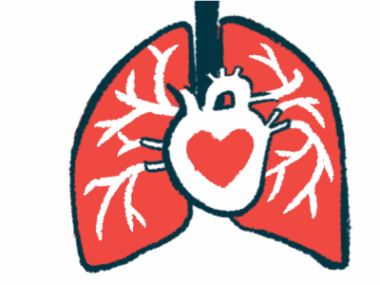Heart imaging may help ID at-risk cardiac sarcoidosis patients: Study
Noninvasive scan may be used as predictor of worse clinical outcomes
Written by |

A noninvasive heart imaging scan may help identify cardiac sarcoidosis patients at risk of worse clinical outcomes, according to a study.
A value of 42% or lower in left ventricular ejection fraction, or LVEF, a measure of how much blood is being pumped out of the heart’s left ventricle with each contraction, was linked with ventricular arrhythmia — abnormal heartbeats that originate in the lower heart chambers, or ventricles — and death due to any cause.
In addition to a low LVEF, younger age, scar tissue in the heart, and a history of ventricular arrhythmia all were independent risk factors for poorer outcomes for patients.
“To our knowledge, this is the first study to determine the optimal LVEF cutoff for risk stratification in patients with definite diagnosis of [cardiac sarcoidosis],” the researchers wrote, adding that their cutoff determination “suggests that moderate to severe left ventricular … dysfunction is not required for adverse outcomes to occur.”
The study, “Optimal left ventricular ejection fraction in risk stratification of patients with cardiac sarcoidosis,” was published in the journal EP Europace.
Trying to identify patients at risk of worse clinical outcomes
Sarcoidosis, an immune system disorder, is characterized by the formation of small clumps of inflammatory cells, called granulomas, in the body’s tissues.
Less than 10% of patients are said to show symptoms of cardiac sarcoidosis, in which granulomas are found in the heart. This can be accompanied by an irregular and fast heartbeat, known as atrial fibrillation, and cardiac dysfunction.
However, heart imaging and other analyses have suggested that cardiac sarcoidosis may be more prevalent than is thought, affecting up to 30% of patients.
According to researchers, early diagnosis of cardiac sarcoidosis — and identifying patients who are at risk of worse outcomes — is still a challenge. To address this, a team at the Cleveland Clinic, in Ohio, sought to determine the optimal cutoff value of a patient’s LVEF that predicts the risk for ventricular arrhythmia and death by any cause.
Secondary goals included individual rates of ventricular arrhythmia and all-cause mortality.
The analysis included 273 patients with well-established cardiac sarcoidosis, who were followed at their center between April 2001 and February 2021. The mean age of these patients was 59, and 40% were women.
A total of 13 patients (5%) had isolated cardiac sarcoidosis — meaning it only affected the heart and none of the other organs — while atrial fibrillation was seen in 41%. Sarcoidosis was confirmed by tissue biopsy, mostly commonly the mediastinal lymph node (75%). Mediastinal lymph nodes are located in the thoracic or chest cavity.
Treatment included prednisone (85%), methotrexate (64%), and the anti-inflammatory medication leflunomide (31%). About a third of patients were treated for abnormal heartbeats (arrhythmias, 26%) and to prevent blood clots (anticoagulants, 32%).
An implantable cardioverter-defibrillator (ICD), a small device to keep the heart rate in check, was used by 157 patients (58%), while a permanent pacemaker — a device that helps the heart beat in a regular rhythm — was used by 22 patients (8%).
All patients were evaluated by a heart ultrasound after a median of 26 months, or just longer than two years, after diagnosis. A follow-up fluorodeoxyglucose-positron emission tomography (FDG-PET), an imaging technique that uses a small amount of a radioactive tracer, was done with 86% of patients at a median of 40 months, or just longer than three years, after diagnosis.
A cardiac MRI was completed for 185 patients at a median of three months after diagnosis.
Low LVEF, younger age, poor history all linked to higher risk
In 63% of patients, the PET scan revealed an abnormal metabolism.
After a median follow-up of 7.9 years, the rate of the composite primary measure was 38%, with 83 ventricular arrhythmias and 32 all-cause deaths.
The annual rate for ventricular arrhythmia increased from 2% in the first year to 8% in the third year. By the fifth year, the rate was 11%.
After 10 years of follow-up, it reached 26%. The five-year survival rate was 97%.
Of the 157 patients with an ICD, 119 (76%) used it to prevent sudden cardiac death. A total of 65 patients had an ICD shock, most of which (91%) were deemed appropriate, meaning the device sent an electrical pulse to restore the normal heart rhythm. Overall, the rate of ICD shock after five years was 7.9%.
Antitachycardia pacing therapy, an established strategy that terminates arrhythmias, was used in 48% of the patients with an ICD.
A cutoff LVEF value of 42% or lower was optimal for identifying a patient’s risk of ventricular arrhythmia and death by any cause, with an area under the receiver operating curve of 76%. In this measure, higher values (maximum is 100%) correspond to greater ability at assessing an outcome of interest. This cutoff value had a sensitivity of 51% and a specificity of 88% — a test’s sensitivity is its ability to correctly identify those with a given disease, while specificity refers to accurately identifying those without that disorder.
The cutoff value was the same in patients without a history of ventricular arrhythmia.
Younger age, a history of ventricular arrhythmia, lower LVEF, and the presence of scar tissue detected by cardiac MRI and/or PET were all independent risk factors for the main composite endpoint and for ventricular arrhythmia. Independent risk factors for death by any cause included lower LVEF, scar tissue, and the levels of NT-proBNP, a heart damage biomarker.
Overall, while the researchers identified an optimal LVEF cutoff, this alone “should not guide ICD implantation but prompt further investigation with advanced cardiac imaging and monitoring,” the team concluded.






